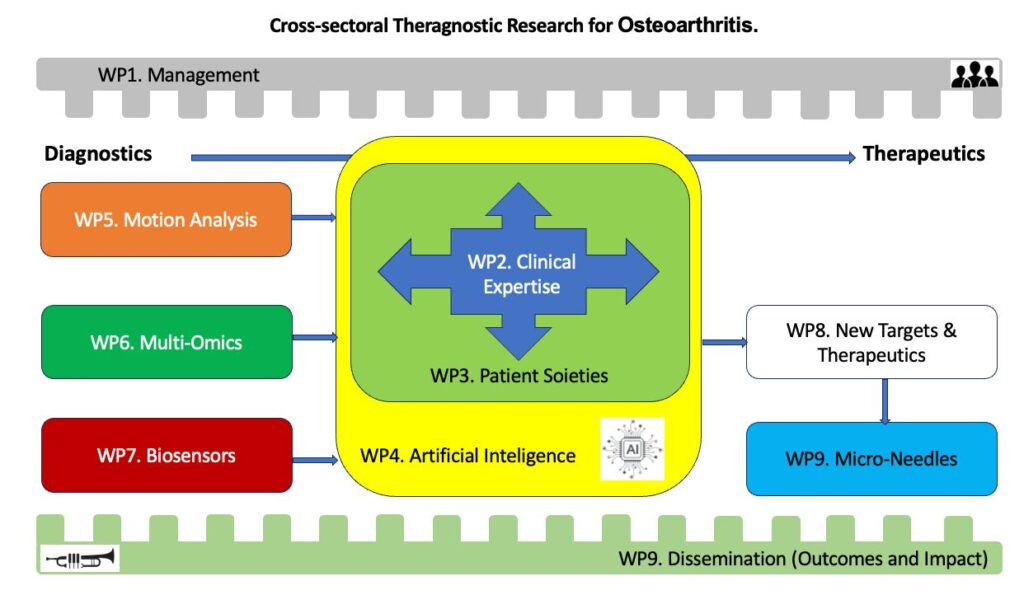
…
Objectives & Ambition
Osteoarthritis (OA) is a heterogeneous [1] and complex [2] disease with a cascade of intervening periods of inflammation, degeneration and regeneration in and around articular joint structures (Figure 1). It has multiple challenges including high rates of disability, comorbidity and recently mortality [3,4,5,6,7]. Our Mobility-Motion Analysis, Multi-Omics, Novel Biosensors for Osteoarthritis Diagnosis and New Therapeutics Delivery project proposal is aligned to pioneer an integrated innovative and patient-centered interdisciplinary approach by creating new tools for the early and precise diagnosis, prevention, therapeutics and outcome-based management of OA.
The proposal is prepared to be submitted to the Innovative Health Initiative (IHI) 9th Call, for the topic HORIZON-JU-IHI-2025-09-05 entitled “Boosting innovation for better assessment of the added value of innovative integrated healthcare solutions”. In the scope of our project proposal, we focused on the development of new and improved methodologies for the comprehensive assessment of OA as well as therapeutic solutions beyond the state of the art. Solutions are easy to use, safe, patient-centered and cost-effective.
Biomechanics is an integral part of evaluation of musculoskeletal conditions. Integrating an artificial intelligence (AI) based marker-less motion analysis system (WP5) (https://doi.org/10.3389/fdgth.2024.1324511) into our diagnostic algorithm is our first objective. This technology has for pillars. First of all, patient will not have to go to a hospital and/or medical center for assessing their condition. They can record their own motion by their mobile phones or personal computers and upload their recording to the web site (https://www.maimotion.com/) for the diagnosis and progression of their condition before and after treatment. This comprehensive motion analysis technology enables patients, clinicians and researchers to gain deeper insights into joint dynamics, movement patterns and biomechanical parameters. The second pillar of this technology is the advanced 3D mesh technology that captures detailed motion data, creating a visual representation of joint movement with unparalleled accuracy. This allows for a comprehensive understanding of the intricacies of musculoskeletal motion. In the third pillar the technology goes beyond traditional motion analysis that can integrate 3D volumetric MRI data. This integration enables the correlation of motion data with structural information, providing a holistic view of musculoskeletal health. Finally, powered by AI, MAI-Motion offers intelligent decision support tools that aid in diagnosis, treatment planning and rehabilitation strategies. This AI-based technology places the OA patient into the center of diagnosis and decision making, which can be used to assess the efficacy and effectiveness of treatments. Information gained in OA can be transferred to commonalities like rheumatoid (RA) and psoriatic (PsA) arthritis.
Multi-omics (WP6) includes genomics, transcriptomics, proteomics, metabolomics and lipidomics. This discipline integrates bioinformatics, biochemistry and physics for the better understanding of biological processes. Our multi-omics teams have been working to refine this technology for the last three years (https://chondromics.org/). Our objective is to expand our multi-omics knowledge from synovial joint fluid (SJF) to serum markers that can predict the early onset of the disease, monitor the natural course of OA and highlight the response to our treatments. Generated information will be than translated to WP7 where we are willing to produce micro-fluidic and surface plasmon resonance (SPR) biosensors for predicting inflammatory, catabolic and anabolic changes in OA. We have recently published our protocol on phospholipid enrichment in SJF (https://doi.org/10.3390/separations11090262) as a new metal oxide affinity sorbent under the scope of the PhD thesis of Serhat Aladağ PhD and the Scientific and Technological Research Council of Türkiye (TÜBİTAK) granted project in relevance to the EU COST CA21110 – “Building an open European Network on OsteoArthritis research (NetwOArk)” Action (https://chondromics.org/).
The complex and mega-data generated by motion analysis and multi-omics research will be harmonized by federated learning techniques and processed by AI (WP4). Cross-sectoral innovators including clinicians (WP2) and patient societies (WP3) will put their expertise in for decisions, while employing privacy-preserving methods. Generated patient data will be protected according to the Regulation (EU) 2016/679 and the Directive (EU) 2016/680. Personalized therapeutics (WP8) including nucleic acids and blood-tissue-cell-based regenerative interventions will lead to and sustain targeted intervention strategies. Personalized therapeutics can furthermore be delivered by an already established peptide delivery system – the cmRNA delivery for bone regeneration (EU H2020 grant 874790) that will be transferred to this research [8]- and/or into the subcutaneous blood circulation using micro needles (WP9).
…..
References:
[1] Roemer FW, Jarraya M, Collins JE, Kwoh CK, Hayashi D, Hunter DJ, Guermazi A. Structural phenotypes of knee osteoarthritis: potential clinical and research relevance. Skeletal Radiology 2023;52:2021-30.
[2] Sampath SJP, Venkatesan V, Ghosh S, Obesity, Kotikalapudi N. Metabolic syndrome and osteoarthritis-An updated review. Current Obesity Reports 2023;12:308-31.
[3] Perruccio AV, Young JJ, Wilfong JM, Power JD, Canizares M, Badley EM. Osteoarthritis year in review 2023: Epidemiology & therapy.
[4] Osteoarthritis and Cartilage 2024;32:159–65.
[5] GBD 2021 Osteoarthritis Collaborators.
[6] Global, regional and national burden of osteoarthritis,1990–2020 and projections to 2050: a systematic analysis for the Global Burden of Disease Study 2021.
[7] Lancet Rheumatol 2023;5: e508-22
[8] Della Bella E, Menzel U, Naros A, Kubosch EJ, Alini M, Stoddart MJ. Identification of circulating miRNAs as fracture-related biomarkers. PLoS ONE 2024:19(5): e0303035.
